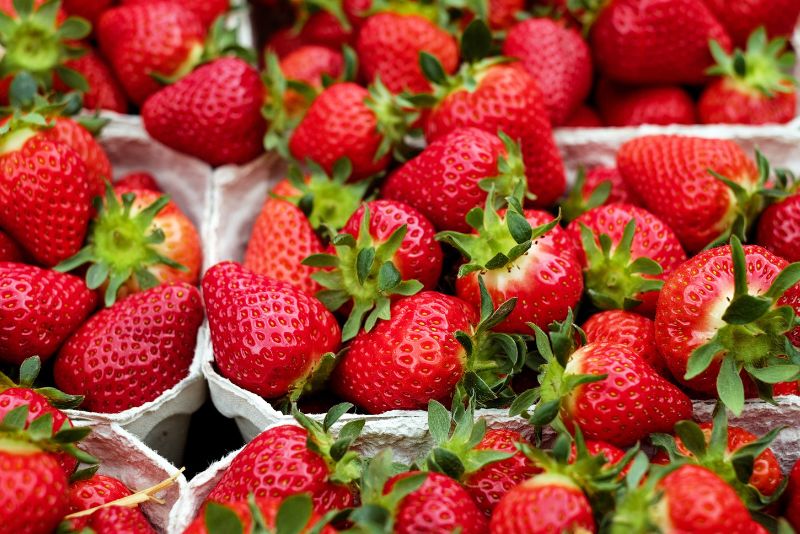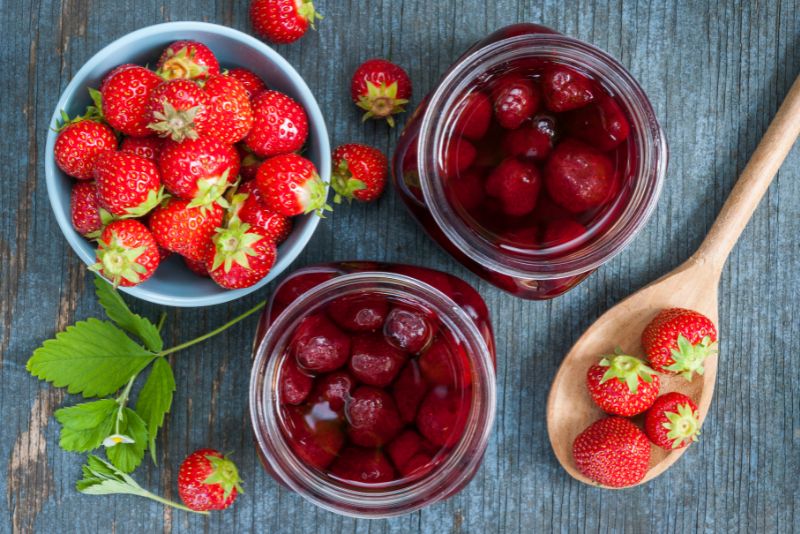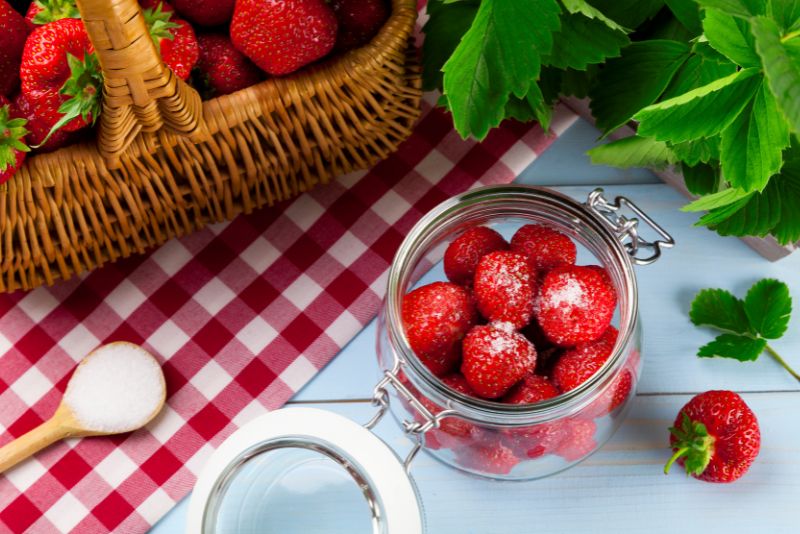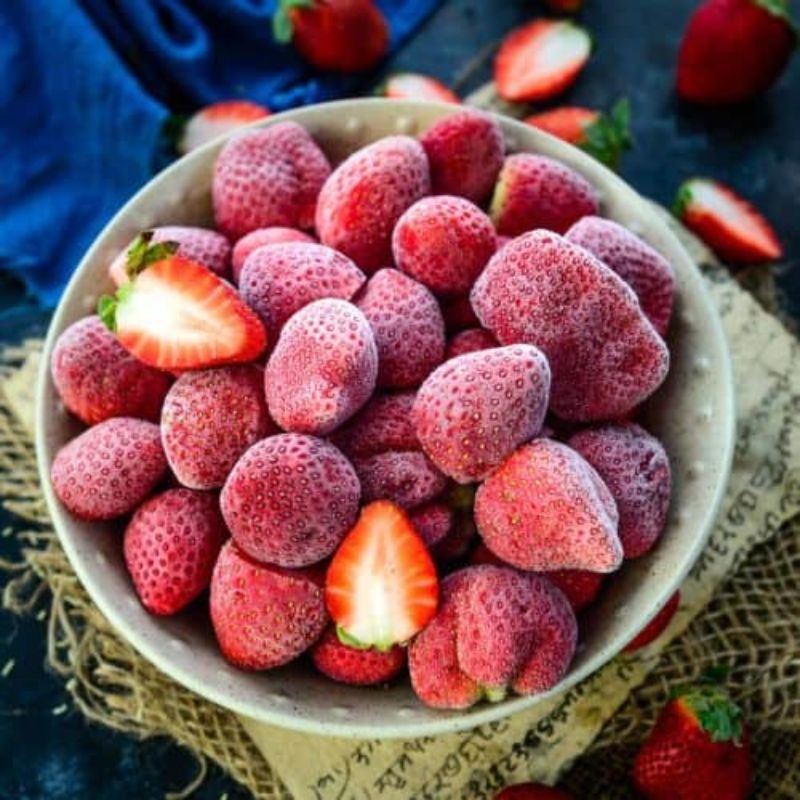Have you ever experienced the disappointment of opening up a pint of luscious, vibrant strawberries only to discover that they have already begun to spoil? It’s a common occurrence that can leave you feeling frustrated and disheartened. After all, fresh strawberries are expensive, and throwing them away feels like a wasted opportunity to enjoy a delicious and nutritious treat. Thankfully, several tried and true methods can help you extend the freshness of your strawberries, ensuring that they last for more than just a few days.
If you’re eager to learn valuable strawberry storage tips to keep your berries fresh and flavorful throughout the week, you’ve come to the right place! Keep reading to discover the secrets of prolonging the life of your beloved strawberries.
How to Store Strawberries
When it comes to storing strawberries in the refrigerator, there are a few methods that can help keep them fresh for up to a week. One option is to transfer unwashed strawberries into an airtight glass food storage container or mason jar, ensuring they are tightly sealed. This method helps maintain the freshness and prevents unwanted odor from seeping in.
Another method is the paper towel technique. By placing a clean and dry paper towel in a container, you can then arrange the unwashed strawberries on top of it. Once the lid is securely closed, the container can be stored in the refrigerator. The paper towel helps absorb any excess moisture, which can contribute to spoilage while providing a protective barrier for the strawberries.

The vinegar solution method can be used for those who prefer a more thorough cleaning. Soaking the strawberries in a mixture of one part white vinegar and three parts water for a few minutes can eliminate any potential bacteria or mold. After draining the strawberries and patting them dry, they can be placed on a clean paper towel in a glass container. The lid can be loosely placed on top for proper air circulation and then stored in the refrigerator.
Regardless of the chosen method, examining the strawberries for any signs of mold or spoilage before consuming them is essential. This simple precaution ensures that only fresh and safe berries are enjoyed.
Should strawberries be stored in an airtight container?
The best way to store your berries depends on whether they are whole or sliced. If you have whole berries, avoid storing them in an airtight container, as this can lead to quicker mold growth due to trapped moisture. Instead, a suitable method is loosely placing the whole berries in an open container lined with paper towels. This allows for air circulation, and the paper towels help absorb excess moisture, keeping the berries dry and fresh. A berry bowl or colander is excellent for this purpose, as it allows air to circulate the berries.

On the other hand, if you have sliced or hulled strawberries, the best approach is to store them in an airtight container. This is because once the strawberries have been cut, their flesh is exposed and more prone to drying out. Keeping them in an airtight container helps prevent this and inhibits bacteria growth. It is worth noting that sliced strawberries do not last as long as whole ones, so it is advisable to keep them full for as long as possible before cutting them.
How to Store Strawberry Purée
To properly store strawberry purée, you can follow a few key steps. Firstly, ensure you have a clean and airtight container suitable for freezing. Removing any excess air from the receptacle is essential to prevent freezer burn. Next, pour the strawberry purée into the container, leaving space at the top for expansion. Seal the container tightly and label it with the date to keep track of its freshness. Place the container in the freezer and allow it to freeze completely. Once frozen, the strawberry purée can be stored for up to three months. When ready to use it, thaw it in the refrigerator overnight or defrost it in the microwave on a low setting. Enjoy the vibrant and delicious flavor of your homemade strawberry purée whenever you desire!

How to Preserve Strawberries
Preserving strawberries is a beautiful way to enjoy their deliciousness year-round, and canning is a prevalent method for achieving this. By canning whole, hulled strawberries, you can use them in various delightful treats such as pies, buckles, and so much more. When selecting strawberries for canning, it’s best to go for fresh, firm berries free from blemishes.
There are two primary options for canning strawberries – with or without sugar. Canning strawberries with sugar helps them maintain their natural flavor and texture over time, making them a preferred choice for many. However, some individuals ignore the sweet additive, as it is unnecessary. Ultimately, deciding whether to preserve your strawberries with or without sugar boils down to personal preference. Nevertheless, we recommend using sugar as it aids in protecting the color and texture of the strawberries.

To can strawberries with sugar, follow the simple steps below. Gather approximately three pounds of fresh strawberries, yielding one quart of preserved berries.
- Start by washing the strawberries thoroughly, hulling them, and cutting off the stems.
- Place the prepared strawberries in a large bowl and sprinkle them with ¾ cup of white sugar. Make sure to stir the strawberries gently to ensure that each berry is evenly coated with sugar, being careful not to break them apart.
- Cover the bowl and let the strawberries macerate in the sugar for around six hours. It’s best to refrigerate them during this time.
- While the strawberries are macerating in the refrigerator, take the opportunity to clean your jars, lids, and any canning tools you’ll be using thoroughly.
- Once the strawberries have rested and absorbed the sweet goodness of the sugar, transfer them to a pot and heat them over medium-low heat. Stir occasionally until the sugar is completely dissolved and everything is thoroughly heated.
- Carefully transfer the strawberries to a heated quart jar in the oven using a funnel. The horn will aid in keeping the rim of the pot clean.
- When filling the jar with strawberries, ensure there is about ½ an inch of space left at the top. This allows room for the strawberry juices.
- After pouring the strawberry juices into the jar, clean the rim and loosely cover it with a clean lid.
- Now, it’s time to process the jar. Use tongs to carefully place it in a pot of boiling water, ensuring it is entirely submerged. Leave the jar in boiling water for about 15 minutes (if you live above sea level, it may take approximately 20 minutes).
- Once the processing time is complete, carefully remove the jar from the boiling water using tongs and place it on a dish towel to cool. Allow the pot to cool for 24 hours before indulging in its delicious contents.
We have a few suggestions if you need help savoring your preserved strawberries! Consider adding them to a comforting bowl of oatmeal or creating a delightful yogurt parfait. Alternatively, let your creativity shine by using them as a delectable ice cream or cheesecake topping. The possibilities are endless when it comes to enjoying these preserved treasures!
Can You Freeze Strawberries?
Yes, you can freeze strawberries! And unlike other foods, strawberries can be frozen in almost any form—whole, halved, sliced, or crushed. Freezing pre-cut strawberries is an excellent option if you plan to use them in a delicious dessert or a healthy smoothie. Start by placing the berries cut-side down on a wax paper-lined cookie sheet to do this. Let them freeze for a few hours until they are firm, and then transfer them to an airtight container. Label and date the container before putting it back in the freezer. When using this method, your frozen strawberries should stay fresh for about 10 to 12 months, which means you can enjoy them throughout the year.

If you want to thaw your frozen strawberries, you can use several methods. The first option is to move them from the freezer to the fridge and let them melt slowly over at least six hours. This gradual thawing process helps maintain the taste and texture of the strawberries. Another option is to defrost the strawberries by running them under cold water for at least 30 minutes. This method is quicker than the fridge but allows strawberries to thaw gently. Alternatively, you can place the frozen strawberries in a bowl within a giant bowl that’s filled with cold water. This method usually takes about 15 to 30 minutes, depending on the size of the strawberries and how frozen they are.
It’s important to note that once thawed, strawberries may appear a bit darker in color and have a softer texture compared to fresh ones. This is normal and doesn’t affect their taste. If you want to decorate a berry cake or pie with perfectly fresh-looking strawberries, it is better to use fresh ones instead of thawed ones. However, thawed strawberries work perfectly fine in smoothies or as a topping for yogurt or cereal. So don’t hesitate to freeze your strawberries and have them ready whenever you need a burst of fruity flavor in your dishes!
Do strawberries last longer in the fridge or on the counter?
If you have yet to make plans to use the strawberries, storing them in your refrigerator is highly recommended. Doing so can extend their freshness and preserve their delicious flavor for longer. Unlike when left unrefrigerated, where they typically last only a few days before showing signs of spoilage, refrigerating them can significantly increase their lifespan, allowing them to remain in good condition for up to a week.
How are strawberries best stored?
If you want to ensure that your strawberries stay fresh and delicious for longer, storing them in the refrigerator is the best way. However, remember a few essential tips to maximize their shelf life.
Firstly, you must resist pre-washing your strawberries before storing them. While removing any dirt or debris is a good idea, doing so can negatively impact their freshness. Strawberries are at their best when they are dry and cold, and any added moisture can cause them to become soft and even develop mold.
Another tip is to leave the stems on your strawberries. While it may be tempting to remove them for convenience or aesthetics, keeping the limbs intact can help preserve the fruit’s flavor and texture. The stems are a natural barrier, preventing excessive moisture from seeping into the strawberries.
Additionally, it’s essential to store your strawberries in a single layer. Placing them on top of one another can cause unnecessary pressure, leading to bruising and spoilage. By arranging them in a single layer, you allow for proper air circulation, which helps maintain their freshness.
Following these simple guidelines, you can ensure that your strawberries stay fresh, juicy, and mold-free for an extended period in the refrigerator. Enjoy your delicious berries when you can indulge in their sweet and vibrant flavor!
Is it better to store strawberries cut or whole?
With their luscious red exteriors and juicy interiors, whole strawberries can ward off spoilage for an extended period compared to their cut-up counterparts. To preserve their pristine freshness, you should maintain the strawberries in the same whole and unaltered state where you discovered them at the grocery store or farmers’ market. This entails leaving the vibrant green-leaf tops intact, as they protect the succulent fruit from premature decay. When storing these delectable fruits, a helpful technique is to line a plastic or glass container with absorbent paper towels. The paper towels act as a barrier, absorbing any excess moisture that may hasten the spoilage process and ensuring that the strawberries remain in peak condition for longer.
Do strawberries last longer, washed or unwashed?
There are numerous benefits to washing strawberries rather than consuming them unwashed. Not only does washing strawberries contribute to improved overall health, but it also plays a crucial role in extending their freshness. By engaging in the practice of thoroughly cleansing strawberries, individuals can ensure that they are consuming a product that is free from potential contaminants and pesticides. Moreover, washing strawberries helps to remove any dirt, debris, or harmful bacteria that may be present on the surface of the fruit. This simple washing significantly reduces the risk of foodborne illnesses and promotes food safety.
Furthermore, by removing any impurities, washing strawberries also contributes to their longevity. By eliminating substances that could potentially accelerate spoilage, the shelf life of the strawberries is extended, allowing individuals to enjoy their succulent flavor for a more extended period. Therefore, washing strawberries before consuming them is highly advisable to reap the health benefits and prolong their freshness.
Is it better to store strawberries in glass or plastic?
Storing Method: Stored in an airtight glass jar to maintain freshness and extend shelf life.
About this method: One highly recommended technique, repeatedly endorsed by numerous experts, involves the utilization of an airtight glass jar, such as the well-known Mason jar, as a storage vessel for fresh strawberries. This efficient approach entails directly depositing the unwashed strawberries into the container above, then securely fastening the lid and transferring it to the refrigerator. By implementing this method, individuals can effectively safeguard the strawberries from external factors and preserve their long-term optimal condition.
Is it better to store strawberries in a jar?
What is this genuinely incredible tip that I am about to share with you? It’s pretty simple. All you need to do is carefully place your delectable fruits, such as those delightful strawberries, into a sturdy glass jar. But wait, there’s more! You then store this fruity goodness jar in your refrigerator’s cool embrace. And voila! Like magic, your precious fruits will stay fresh and tantalizingly scrumptious for a remarkable period – 2 to 3 whole weeks, to be exact! As astonishing as it may sound, this particular method of food storage has gained quite a bit of popularity within the zero-waste community. And why wouldn’t it? It’s an ingenious way to minimize waste while extending the lifespan of our beloved fruits. So try this tip and witness the wonders it can bring to your culinary adventures!
Can you store strawberries in a Ziploc bag?
To properly store your strawberries and extend their shelf life, carefully place them into a spacious plastic sealable bag. Once all the strawberries are in the bag, securely seal it to prevent air or moisture from entering. Doing so creates an ideal environment for the strawberries to stay fresh and delicious for longer. It is advisable to then transfer the sealed bag of strawberries to the refrigerator, where they can be safely stored. This relaxed, dry environment will help preserve their quality and prevent decay or spoilage. With this method, you can expect your strawberries to remain fresh for approximately five to seven days. Enjoy your flavorful strawberries for an extended period by following these simple storage instructions!
Can you keep strawberries in the fridge for two weeks?
Strawberries can last a week in the fridge, but rinsing them in vinegar extends their freshness to two weeks. At room temperature, they only stay a couple of days.
What is the best way to store strawberries after washing?
Once your delicious strawberries have undergone a thorough cleaning and drying process, it is of utmost importance to ensure their longevity by storing them in a meticulously sealed, airtight container thoughtfully lined with absorbent paper towels. This ingenious technique will effectively aid in absorbing any lingering moisture, optimizing the strawberry’s freshness and flavor. By diligently adhering to these proper washing and storage practices, you can confidently anticipate a delightful shelf life of approximately two weeks for your delectable strawberries when nestled snugly within the cool confines of your refrigerator.

